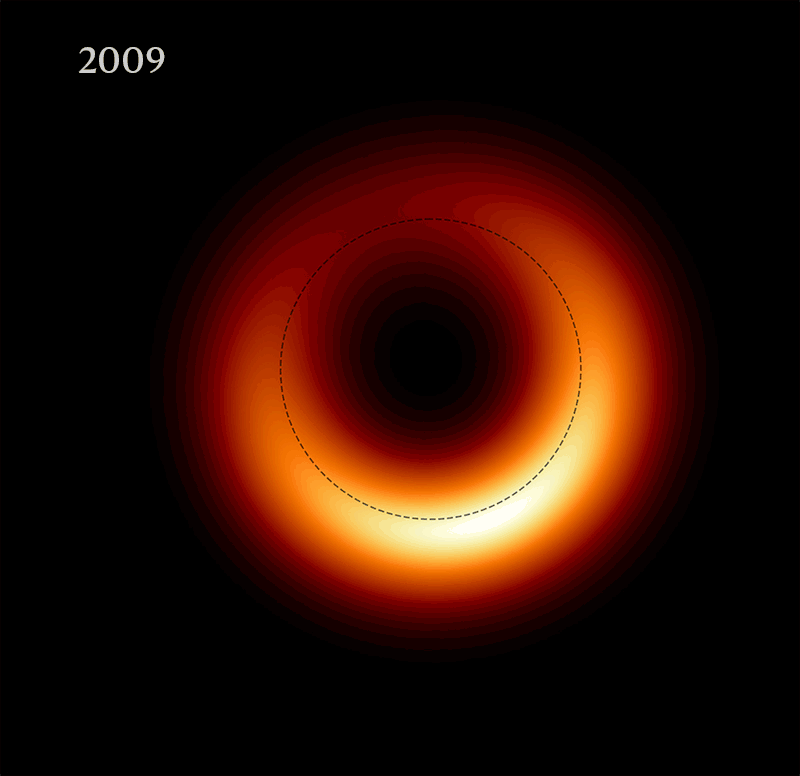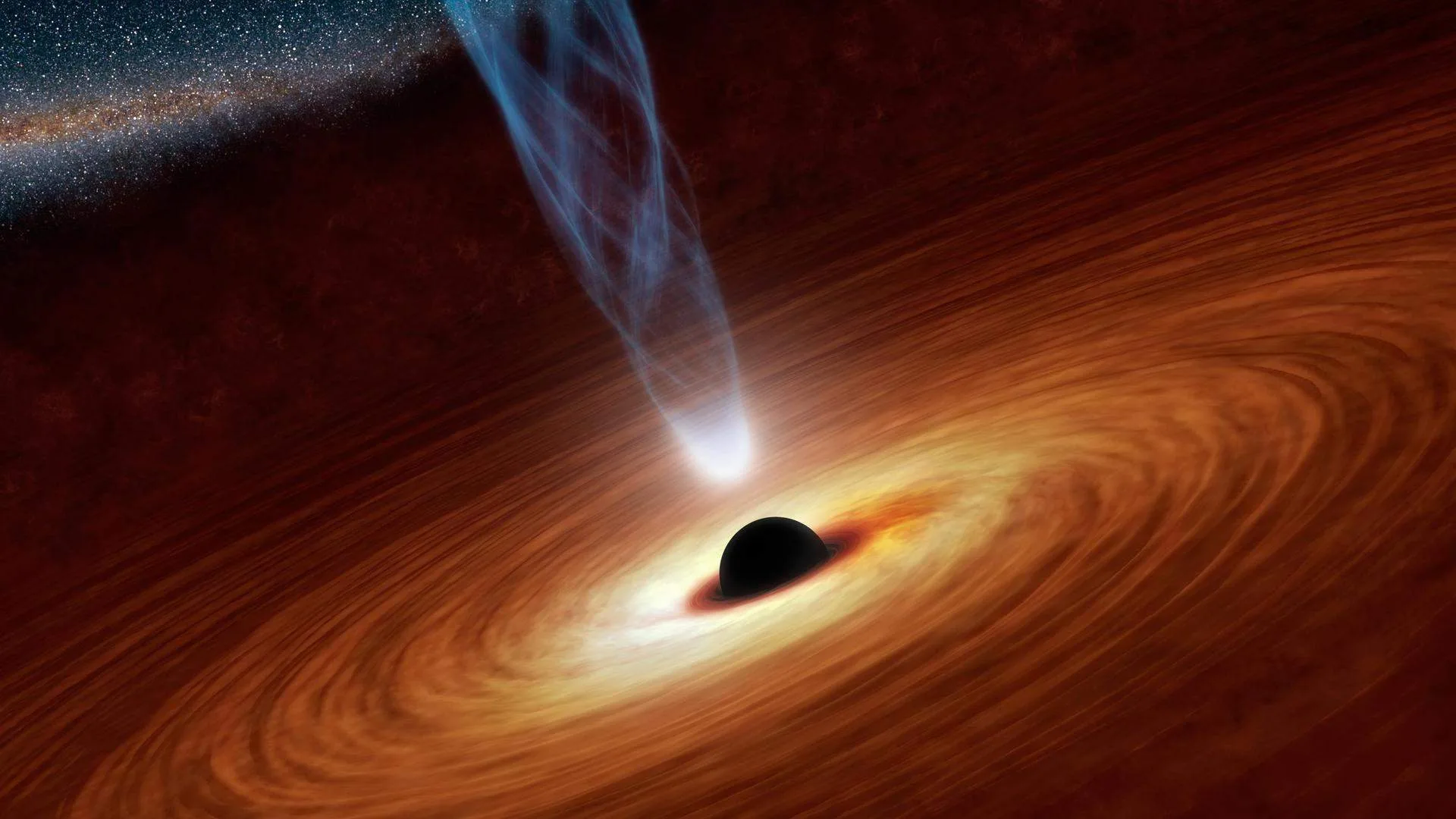Pictures created from old observations show the void’s stormy evolution over the past decade.

The historic first image of a black hole unveiled last year has now been turned into a movie. The short sequence of frames shows how the appearance of the black hole’s surroundings changes over years as its gravity stirs the material around it into a constant maelstrom.Black hole pictured for first time — in spectacular detail
The images show a lopsided blob of light swirling around the supermassive black hole at the centre of the galaxy M87. To create them, the Event Horizon Telescope (EHT) collaboration — which harnesses a planet-wide network of observatories — exhumed old data on the black hole and combined these with a mathematical model based on the image released in April 2019, to show how the surroundings have evolved over eight years. Although it relies partly on guesswork, the result gives astronomers rich insights into the behaviour of black holes, the intense gravity of which sucks in matter and light around them.
“Because the flow of matter falling onto a black hole is turbulent, we can see that the ring wobbles with time,” says lead author Maciek Wielgus, a radio astronomer at Harvard University in Cambridge, Massachusetts.
The work, which appeared on 23 September in The Astrophysical Journal1, offers a taste of what the team might be able to do in the near future, as its techniques improve. “In a few years, it could really start to look like a movie,” Wielgus says.
Wobbling ring
The black-hole image that the EHT collaboration unveiled last year made the front pages of newspapers around the world. It portrayed M87*, the supermassive black hole at the centre of the M87 galaxy, some 17 megaparsecs (55 million light years) away. The researchers constructed the picture by combining radio-frequency signals they had collected from observatories across Earth over two nights in April 2017. Their feat has been compared to resolving the shape of a doughnut on the surface of the Moon from Earth.
Although blurry, the image matched the predictions of Albert Einstein’s general theory of relativity for what the immediate neighbourhood of a black hole should look like. In particular, it gave researchers the first direct evidence of the shadow of an event horizon, the surface of ‘no return’ that separates a black hole from its surroundings. This darker disk was set against a ring of light emitted by superheated matter just outside the event horizon.
Strikingly, one side of the ring appeared brighter. This was expected, owing to a combination of effects in the complex dynamics around a black hole. In particular, matter falling into the void should spiral at a high velocity outside the black hole’s equator, forming what astrophysicists call the accretion disk. The lopsided look is in part to do with the Doppler effect: on the side of the disk that rotates towards the observer, the motion of the matter boosts the radiation, making it look brighter; the opposite happens on receding side.
Revisiting data
On the basis of those results, Wielgus wanted to go back and look at the older data from EHT telescopes to see whether he could reinterpret them, using the 2017 picture as a guide. The EHT had been observing M87* since 2009, initially using telescopes at just three locations. As the team added more observatories to the EHT network, the quality of the observations improved. In 2017, the collaboration involved eight observatories that spanned the globe from Hawaii and Chile to Europe, reaching for the first time the level at which the EHT could produce an actual image.
The older data consisted of four batches, collected in 2009, 2011, 2012 and 2013, two of which had remained unpublished. “To a degree, they were forgotten, because everyone was super excited about the 2017 data,” Wielgus says. With a group of other EHT researchers, he reanalysed the data and found them to be consistent with the results of the 2017 campaign, including the presence of a dark disk and a bright ring. And although, by themselves, the 2009–13 data batches did not have sufficient resolution to produce pictures, the team was able to generate synthetic images for each of the years by combining the limited data available with a mathematical model of the black hole built from the 2017 data.
And the results turned out to contain more information than Wielgus expected. Like the 2017 picture, they revealed that one side of the ring was brighter than the other — but the bright spot moved around. This could be because different regions of the accretion disk became brighter or dimmer, which could enhance or sometimes even cancel out the Doppler brightening.
Dynamic disk
This was not unexpected, the authors say: although the M87* black hole itself does not change from year to year, the environment around it does. On a scale of several weeks, strong magnetic fields should stir the accretion disk and produce hotter spots that then orbit the black hole. In 2018, a separate team reported evidence of a blob of hot gas circling Sagittarius A*, the Milky Way’s central black hole, over the course of around 1 hour. Because M87*, at 6.5 billion times the mass of the Sun, is more than 1,000 times the size of Sagittarius A*, the dynamics around M87* take longer to unfold.
The EHT collaboration attempts to observe M87* and Sagittarius A* every year, in late March or early April. That is when weather conditions are most likely to be good simultaneously at the many sites in its network. The 2020 campaign had to be scrapped because of restrictions owing to the COVID–19 pandemic, but the team hopes to have another chance in 2021. If all goes well, more observatories — including one in Greenland and one in France — will join the effort.
The team also hopes that next year’s campaign will include its first global observations using shorter-wavelength radiation. Although more challenging to see through Earth’s atmosphere, this would improve the resolution of the EHT images. “We would get even closer to that black-hole shadow, and get sharper images,” says EHT member Sara Issaoun, a radio astronomer at Radboud University in Nijmegen, the Netherlands.
Source : The first-ever image of a black hole is now a movie (nature.com)







